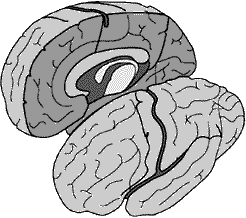Brain & Mind
You may hear about brain washing, may be fooled with kids’ jokes like brainless or maybe you heard this word brainstorm from the Clara Gallardo’s class. All of them have something to be with the main source of your sick ideas.
The brain is like an extensive intricate sponge through nuclei within its path, absorbing every crumb within its path, to be used at some latter-date, neurons hold information of one's own free will, and embrace that which is precious and dear to them.

The cerebral hemispheres are divided right down the middle into a right hemisphere and a left hemisphere. Each hemisphere appears to be specialized for some behaviors. The hemispheres communicate with each other through a thick band of 200-250 million nerve fibers called the corpus callosum.
- Right Side - Left Side
The right side of the brain controls muscles on the left side of the body and the left side of the brain controls muscles on the right side of the body. Also, in general, sensory information from the left side of the body crosses over to the right side of the brain and information from the right side of the body crosses over to the left side of the brain. Therefore, damage to one side of the brain will affect the opposite side of the body.
In 95% of right-handers, the left side of the brain is dominant for language. Even in 60-70% of left-handers, the left side of brain is used for language. Back in the 1860s and 1870s, two neurologists (Paul Broca and Karl Wernicke) observed that people who had damage to a particular area on the left side of the brain had speech and language problems. People with damage to these areas on the right side usually did not have any language problems. The two language areas of the brain that are important for language now bear their names: Broca's area and Wernicke's area.
So, we have just one brain, but it's divided in regions according to the functions they control. =P and there we go!

0 Comments:
Post a Comment
<< Home